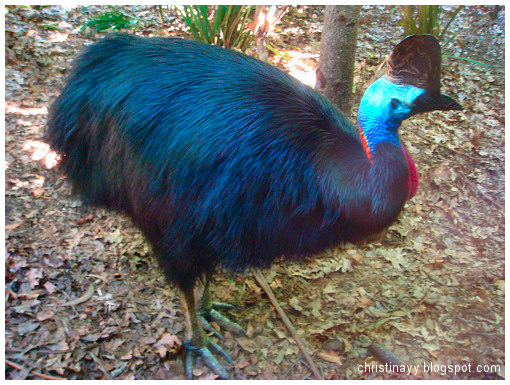The Southern Cassowary is the third tallest and second heaviest living bird, smaller only than the ostrich and emu.
Cassowaries feed mainly on fruits, though all species are truly omnivorous and will take a range of other plant food including shoots, grass seeds, and fungi in addition to invertebrates and small vertebrates.
Cassowaries are very shy, but when disturbed, they are capable of inflicting serious injuries to dogs and children
 cassowary birds
cassowary birds cassowary birds
cassowary birds cassowary birds
cassowary birdsCassowaries (from the Malay name kesuari)[3] are part of the ratite group, which also includes the Emu, rheas, ostriches, and kiwis, and the extinct moas and elephant birds. There are three extant species recognized today and one extinct:
Casuarius casuarius, Southern Cassowary or Double-wattled Cassowary, found in southern New Guinea, northeastern Australia, and the Aru Islands,[2] mainly in lowlands.
Casuarius bennetti, Dwarf Cassowary or Bennett's Cassowary, found in New Guinea, New Britain, and on Yapen,[2] mainly in highlands.
Casuarius unappendiculatus, Northern Cassowary or Single-wattled Cassowary, found in the northern and western New Guinea, and Yapen,[2][4] mainly in lowlands.
Casuarius lydekki Extinct[1]
Presently, most authorities consider the above monotypic, but several subspecies have been described of each (some have even been suggested as separate species, e.g., C. (b) papuanus).[4] It has proven very difficult to confirm the validity of these due to individual variations, age-related variations, the relatively few available specimens (and the bright skin of the head and neck–the basis of which several subspecies have been described–fades in specimens), and that locals are known to have traded live cassowaries for hundreds, if not thousands, of years, some of which are likely to have escaped or deliberately introduced to regions away from their origin.[4]
 cassowary birds
cassowary birds.JPG) cassowary birds
cassowary birds cassowary birds
cassowary birdsFemales are bigger and more brightly coloured. Adult Southern Cassowaries are 1.5 to 1.8 metres (59–71 in) tall, although some females may reach 2 metres (79 in),[5] and weigh 58.5 kilograms (129 lb).[6]
All cassowaries have feathers that consist of a shaft and loose barbules. They do not have retrices (tail feathers) or a preen gland. Cassowaries have small wings with 5-6 large remeges. These are reduced to stiff, keratinous quills, like porcupine quills, with no barbs.[6] A claw is on each second finger.[7] The furcula and coracoid are degenerate, and their palatal bones and sphenoid bones touch each other.[8] These, along with their wedge-shaped body, are thought to be adaptations to ward off vines, thorns and saw-edged leaves, allowing them to run quickly through the rainforest.[
.jpg) cassowary birds
cassowary birds.JPG) cassowary birds
cassowary birds cassowary birds
cassowary birds
No comments:
Post a Comment